- I have heard that Date city in the southwestern part of the island of Hokkaido where you grew up is near Lake Toya on the Pacific coast and is a region that is seldom cloudy. I would like to ask you first of all what kind of influence the town of Date had on you as a playwright. And would you also tell us what your first encounter with theater was like?
-
I was born in Gunma prefecture but grew up in my Father’s hometown of Date from the age of two months old. In Date there is a citizen’s theater company (Citizen’s Theater Palam) and my encounter with theater came when I joined that company at the age of ten as a child actor. I auditioned for it at the suggestion of my mother and at the time it was a new company and very active, so I ended up participating in it until my final year of high school (Hokkaido Date Midorigaoka High School). The director of the company, Yoshinori Kageyama, was also the faculty advisor of our high school’s drama club, so I was in the drama club at school too. As a result, it was like theater was the only thing I did from the time I was small.
In the summer when I was 17, our club’s production of Ringo no ki (The Apple Tree) adapted by Mr. Kageyama (based on the work by Ryuji Goto) that I directed was selected as one of the top four in the nationwide high school drama contest, which meant we performed it at the National Theater in Tokyo. The high school drama clubs from the main island (Honshu) were doing works of conversational theater or skit type works while we were there doing this musical type play, so I felt really out of place and very nervous at that performance. At that time I had the opportunity to talk with Oriza Hirata , who was serving on the board of judges for that contest, and I learned that he was a professor of the theater course at Obirin University (J.F. Oberlin University) at the time, so I decided to apply to Obirin. At first, I came to Tokyo with the aim of becoming an actor. It was also partly that I just wanted to come to Tokyo. After starting at the university I served at times as directing assistant for Oriza-san’s theater productions at the university and sometimes performed in them as an actor. I was 20 when I wrote my first play. It was also a time when I was beginning to have doubts about continuing as an actor. Around the same time my grandfather on my mother’s side died, which was a major event in my life. I have written about my grandfather in one of my plays. I started out not really knowing what I was going to write, but I soon realized that I was taking motifs from the local town and my own personal memories. And that remains true in my writing today. So those 18 years that I spent in Date have had a very important influence on my works.- You started your “Mum and Gypsy” theater company in 2007 while you were still at university. Could you tell us about the origin of the company’s name?
After Oriza-san quit his job at the university I lost interest in the classes. For a while I would spend my time working at part-time jobs and then take trips to places as distant as possible. I think it was when I was on a trip to the island of Yakushima that a measure suddenly came to me, and that was “ mum to gipushi ” (mum and gypsy). It was during my senior year at university. Before that, I had started a company named Aranawa Jaguar , but for a number of reasons I disbanded it after a year. Once I was alone again I started pondering seriously for a while about how to mount my works as stage productions. That is why I started going on trips around the country. While I was traveling, one of the first realizations that came to me was that I didn’t have the qualities it took to lead a theater company. So, I decided, rather than establishing a theater company or organization with member actors, production and technical staff and building the necessary structure, I would have to find a way to mount my productions by myself. In that case, of course, I would be the one thinking about the works most, so I would in a sense be the mum (the mother body/organization). And I conceived of a process by which I would take an idea that I thought was interesting and discuss it with my production person, Kana Hayashi, and then we would gather some technical staff and actors and discuss it with them, after which we would prepare it to present to the audience. This personal style of production I had come up with was one that would begin from me and then be communicated from person to person, getting a variety of people involved along the way, as if the work itself were a wandering gypsy. So I expressed this of creating and presenting a theater work in the company name “Mum and Gypsy.”- It seems quite unique that you would choose the word mum for you to refer to yourself, when it is a word that means mother.
I used it in the sense of botai (base, mother body, mother organization, etc.), but it also expressed the fact that I wanted to depict a different kind of “femininity.” My mother was very serious about education, but I also feel now that she was a very feminine woman. As a child I was smothered in [motherly] love, but even so I believe that I was able to see my mother’s very human femininity with objectivity and sensitivity. Still, I don’t understand women, of course. Because I’m a man. Still there is always the desire to try to understand the things that you don’t understand, isn’t there. So I am always interested in the unfathomable aspects of women and want to try to understand them. For example, what did it mean for my mother to move to the remote countryside in Hokkaido in order to marry, or what kind of child she was. It is not limited only to my mother. All the women around me, including my mother, are models for this obsession of mine.- In September of 2007 you presented your Mum and Gypsy company’s maiden production, Soup mo kareta (the soup has dried up too). What kind of work was it?
It was a science fiction type story about a group of girls who land on a planet in outer space. It was single-situation conversational play that took motifs from Mother Goose and Alice in Wonderland. It began from a scene where the aliens of that planet and the girls who had arrived there were about to eat something like sea tortoise. Looking back it must have been a very dumb story. I think it was a story influenced by the many books I was reading as I traveled in the period when I was fed up with university studies, and it must have been pretty boring. I think it also included a part that had the oceans of the earth all dried up, but I don’t really remember (laughs).- What brought about your change in style from that kind of conversational theater to your present style that uses repetitions of scenes?
It came from my third play Horohoro (March 2008), which was also my graduation work. We built about ten partitioned rooms in the small theater of Obirin University, Prunus Hall, and I tried having all the people (actors) in the separate rooms speaking at the same time, for about an hour. So, the audience really couldn’t make out what they were saying or get any meaning out of it all, and they were just sitting their dazed by the onslaught (laughs).
However the idea that I tried in that work definitely connects to what I am doing today. For example, when you think about us having this interview here in this conference room, it is one situation with our definite physical presence and real space, but even as I am being interviewed other thoughts are going through my mind, like the train ride that brought me here and the rehearsal I will be going to afterward. So, the physical presence and the reality of this situation is one aspect but at the same time multiple situations are also going through our minds, aren’t their? When I thought about how to recreate that in a theatrical context, that experiment [ Horohoro ] was the result. From there, I began to create works where story lines didn’t just develop in a linear fashion but where a mix of numerous scenes played out on different time axes and different spaces.- In recent works of Mum and Gypsy you have the young women speaking in everyday language while writhing in unbelievable postures as they talk, in a way that presents a very strong physical aspect. When did this form of expression come into your works.
In the past few years, “memories” have been an important these in our Mum and Gypsy works. The work that started this trend was Dokoka tokuno, soreyori muko – Arui ha awa ni naru fukei (Somewhere far, and beyond that – Or a landscape that becomes bubbles) (June 2008). In this play there are three former elementary school friends who are taking a train together back to their hometown when a train accident occurs. Just before the train crashes they are recalling a series of memories from their childhood, like walking home from school or the cave where they caught a crab. The images of their memories come one after another like the faces of a revolving lantern. For this play we created a full-sized train car in Prunus Hall and used it as the stage where the scenes of their memories were played out one after another. In this play I had adult actors playing the roles of children for the first time. At times they would play themselves as adults and then the scene would switch and they would play themselves as children in their memories. What I realized in the repetition of these role changes was that there is a similarity in the relationship of physical movements and words between children and actors. Children have far less vocabulary than adults. Adults can use their vocabulary to express their thoughts and feelings, but children with their extremely limited vocabulary are unable to express their thoughts and feelings in words, even though they may be as deep as those of adults. I believe there is something in common between that state and the situation of actors. In short, actors are limited to only being able to speak with the vocabulary that I give them in the script. But, when they are acting, I think the actors must be thinking of things beyond the vocabulary I have given them. So, I feel that because they aren’t able to speak in their own words, there are times that they use body language, much like a child squirms when there is something they want you to understand but they can’t express it in words. What I discovered when I tried having adults play child roles was not only the similarities in the body language of children and actors but also a strange sense that the actors were able to use their bodies as a motor to express emotions and spin tales. This discovery brought the stronger physical aspect to Mum and Gypsy works, and it was in the play Kodomo mo Momo mo Mori’n naka (Both Children and Peaches are Part of the Woods) that we premiered at ST Spot (Nov. 2009).- When did you begin to use your method of repeating scenes in a “refrain” effect?
In Dokoka tokuno ,…there is a scene just before the train crash where the line “This train, isn’t it going too fast?” is repeated by the passengers several times. After this line is repeated the train accident occurs. I think this was the first moment that we used scene repetition. However, at that stage it was simply a case of repeating the same scene in the same way.
The repetition method changed greatly in Kodomo mo Momo mo …. How it changed—and this was partly because we were using repetitions more often—was that we were no longer just repeating the “scenes” but we were also repeating the “feelings.” In fact, as I watched the actors’ body movement as they were repeating scenes, I felt an effect as if the actor’s body was growing in volume; there was some definite escalation occurring.
So, as long as the actors were using their bodies and acting out the repetitions, I wondered if there was really any meaning in simply repeating the scenes in exactly the same way. It was also around that time that I realized that the scene repetitions in my plays are not simply a matter of repeating scenes in the same way, but that they created a furtherance of the scene, like a refrain in a song. So, from that point on I stopped referring to them as repetitions and started calling them refrains. This was an important discovery for me.
In this way, the use of refrains became one of my most potent devices, because not only is it effective in presenting subjects in a multifaceted way from a broader range of perspectives, but I also helps add more modulation and gradation to the depictions of the inner thoughts and feelings of the characters. Furthermore, it is effective in portraying a community.
It was in my play Kodomo mo Momo mo … that I started using this refrain approach. This play is a story about three sisters in which the youngest sister dies, but in the lines, instead of using the term “die” ( nakunaru ) the term “goes away” ( inakunaru ) is used. My attempt was to use the expression inakunaru over and over as a refrain that would increase the intensity and weight of the story.- However, isn’t it difficult, in another sense, for the actors to repeat the same lines dozens of times with slight changes in nuance each time?
Yes, it probably is. We rehearse new works for about a month, and since I am a persistent and stubborn type, I make the actors do things over and over again. So, they are not repeating the refrains only in the performances but also all through the creative and preparatory [rehearsal] process. The hour and a half of refrains that the audience sees in one performance is actually the result of a whole month of practicing the refrains for the actors. So, what the audience sees it is just a fraction of the work that has actually gone into it.
Lately, I have the feeling that our refrains are actually going beyond the rehearsal studio and the theater. For example, an office worker goes to the office the day after seeing our performance and as he is sitting at his desk he suddenly has the thought that it is time for today’s Mum and Gypsy performance, so he thinks, “Those girls must be repeating those scenes over and over again,” (laughs). So, in that way the refrains may be running through the minds of the audience in their daily lives and gaining intensity and weight as the refrain goes on. So, I get the sense that the refrains expand out beyond the theater walls and the world of our plays.- In the Mum and Gypsy performances the delivery of even the ordinary lines is broken up into unique phrasing. What is the intent of that type of delivery?
Breaking up the lines into distinct phrases increases the amount of punctuation, and the more punctuation points there are, the more opportunities there are to jump to different scenes. For example, if there is a monologue saying, “This door, I wish it would open,” you could think of it as composed of the three parts “This” and “door” and “I wish it would open.” Then, in the next scene [refrain] you can phrase it in two parts, as “This door,” and “I wish it would open.” By changing the parts after the punctuation, it can become a completely different scene, and by changing the intonation or stress of the last sound of a word, you can also get a seamless transition between monologue and dialogue. It was this discovery of the use of punctuation and phrasing that led me to this style of delivery.- In July of this year (2011) you performed in you hometown of Date the play Matteita shokutaku (the awaited dinner), which is based on a situation where the older and younger sisters of a family who now live in Tokyo return to their hometown for the rites of the first anniversary of their father’s death, and they are received by their older brother, who is a bachelor and still lives alone at the family home. Then in August (2011) you presented a new play Shiofuru sekai (World of sprinkled salt). This is a play based on a situation where a high school girl is saying goodbye to her friends because she has to move away in the aftermath of her mother’s suicide. It seems that a lot of your works involve some form of “loss” or of someone’s “absence.” Why is this?
I believe that many of our most vivid memories come from moments or points in time when something that has been an everyday occurrence or pattern in a person’s life suddenly comes to an end. So, I am interested in the phenomenon of flashbacks, for example. Therefore, I believe that the sudden “absence” of a person in our lives or experiences of “loss” are intimately tied into the process of recollection or reminiscence. In terms of the situations, in Kodomo mo Momo mo … I wanted to write about children who don’t get enough attention from adults, so for the situation I created one with a rather complex family environment where the mother seldom comes home and, thus, it creates a world where adults are absent. As for Matteita shokutaku , my maternal grandfather is the model for the deceased father and the model for the situation was the actual gathering of our family for the third anniversary of my grandfather’s death. With the play Shiofuru sekai I wanted to depict the sea of my hometown of Date. Date has been called the “Shonan of the North” because it looks somewhat like the real Shonan beach of Kamakura with the hills behind the town and the expanse of sea (Uchiura Bay) in front. In that sense, it is very open as a location, but for me, living there until the age of 18, it felt like a very closed town and I couldn’t wait for the chance to leave it. The only way to leave the own is by train, and the station, which was thus the only exit from town, was right by the seashore. So, I was always looking at that sea and dreaming of leaving that town. I wanted to depict that feeling about the outside world that I had until I was 18, and to depict that sea as I saw it back at that time. Also, when I thought about how many artists there might be in the world that can portray the sea, I got the feeling that there might actually be fewer than you would imagine, and that I definitely had the qualifications to try to portray it (laughs). The situation for Shiofuru sekai is one where a high school girl’s mother has committed suicide by throwing herself into the see (a person is suddenly absent), and in the sense of depicting the sea and the sudden loss of people, I thought there would be some people who would be drawn to the thematic connection to this year’s (March) Great East Japan Earthquake and Tsunami. And of course, there were such people. I felt it would be fine if people viewed Shiofuru sekai in that connection.- The Japanese expression shiofuru carries with it a lot of different meanings and nuances. And, in the play we learn that the mother committed suicide by jumping off a cliff into the sea, but there is nothing said intentionally in the play about why she committed suicide. Normally there would be some indication in the story about the reason for the suicide, but the fact that you provide no such indications leads the audience to use their imagination to explain it.
From the beginning I wanted to write about young girls living in a small town of the kind where the wind comes in off the sea and it is a very small community and they have been raised in the kind of environment where their school has only one class for every two grade levels. In terms of image, the shio (salt) may be the salt of the seawater [tides] and by connection it may also suggest, for example, the shio (tides) of the expression for a young girl’s first menstruation (first tide). Salt also carries the image of death in Japan. Those were some of the various images that came to mind when I decided on the title Shiofuru sekai .
Concerning the reason for the mother’s death, the original situation I was thinking of included a much stronger and more specific explanations of the reason for the suicide. For example, the mother had lost one of her breasts to breast cancer, or she was a woman who had a number of boyfriends, or that there was this girl who was watching that kind of mother as she grew rapidly into a woman herself. For a while I also had it a situation where the despair and pain of an illness drove the mother to suicide. In creating a one and a half hour play I begin by writing about three hours worth of scenes and then gradually edit them down, like editing a film. In this case, during the editing process all of the original scenes were edited out. When I arrived at the idea for a final scene where the daughter is romping on the very shore where her mother threw herself off the cliff, I felt that there was no more need to show any of the original scenes explaining the reason for the suicide. I knew that becoming too attached to any specific scenario for the suicide would leave the audience less “undefined space” ( yohaku ) to think, so I thought it would be OK just to say that she clearly became hopelessly depressed about something and dove to her death. On the other hand, using refrains to create that undefined space in the minds of the audience would allow them to reflect on their own experiences, or think about the March disaster, and that would be fine. And I think we succeeded in creating that kind of time.- Death seems to be a primary theme in these works. I there some original experience in your life that relates to death?
I don’t think this is only true of Date. But when I was living in Date I remember numerous experiences of people suddenly disappearing. There were cases where their bodies were found when the snow melted, and there were many cases where the people were just never found again. There were always Missing Person leaflets hanging at the station. Because I grew up in that environment I never thought it was unusual. But, when I took our group to Date to make preparations for our Hokkaido performances, someone commented about how many missing persons leaflet there were, which made me realize anew that I had grown up in that kind of environment.
When someone disappears it sends a shock wave through a town, doesn’t it? But, when a community loses someone or someone disappears, we sometimes experience a sense of the cruelness and irresponsibility of the distance between people that allows us to go on with our lives in security as if the loss isn’t related to us. In short, what I wan to depict is not the tragedy of losing someone but the distance that the surrounding people maintain in the face of the fact that someone has suddenly disappeared from their lives. In the case of Shiofuru sekai , as if unrelated to the fact that the mother has committed suicide, the people around her go on to fall in love, have wet dreams and so on. What I want to depict is the lightness and indifference of that kind of distance between people in a matter of fact way.- How do you create your works with such an abundance of refrains? Do you have a stage script from the start?
At first there is no script. However, there is a clear outline of what I want to do in my head, so on the first day when everyone gathers in the studio to beginning on a new work, I just spend that day explaining the idea to them verbally. Then the work moves to the first stage where I have the actors learn the short lines I have written by word of mouth. We generally know which actors will play each part, but the specifics of each role take shape as the work proceeds. First of all I create a lot of small scenes and record them on my computer as I create one after another. It eventually reaches a total of about 200 scenes. Then I take all those scenes and edit them like editing a film, sometimes changing the order and changing them back or making repeats.
Also, I will have in my mind some quite clear visual images, such as a break-wall of concrete tetra pots out in the water in front of the station, and details like the colors of the benches. I explain these images as if I have just come back from a location hunt and then explain the memories of the characters in the play that will be portrayed, so that we all share the same images. Because there isn’t any specific set on the stage, it is important that everyone has these images very clearly in their minds.
Since there are a lot of refrains, the large majority of the scenes I have prepared and worked everyone through will never actually be used, but they are not meaningless nonetheless, because the scenes that are eventually deleted from the final play still remain in the memories of the actors’ bodies. Normally, actors in other companies will develop their own roles and add to them aspects that aren’t actually written in the script or stage notes. But, I don’t like having actors develop their parts in that way; so everything is done as I direct it. I really dislike having actors develop their roles on their own, so I basically don’t allow them to practice on their own or work with other actors discussing their acting. I have been an actor, so I know there is no benefit from having actors discuss things with each other. It is enough for the actors to just work with the director. Still, I also know that it is not good for the actors and director to become too close. In short, it is all a process of me thinking and deciding as director how the actors’ characters and roles should be developed.
The play Kaeri no aizu (sign of returning) we performed at the Suitengu Pit in June of this year was a short 20-minute piece that forms a trilogy with Matteita shokutaku and Shiofuru sekai . The three works are connected in that they all share the same the concept of human relationships relating to food, but depending on the editing or approach they can also be made into 20-minute works and they can be turned into different works where the episodes, such as family-only stories or friends-only stories, are completely different ( Shiofuru Sekai was performed as the friends version of the trilogy).
Because of the fact that all of the actors acquire a shared understanding of the memories from the lives of the different characters in the play during the rehearsals and the fact that all of the actors are used to this creative method, I can say something like, “Let’s insert that scene we did three months ago at this point,” and in that way proceed with the editing work based on a shared knowledge of all the scenes we have developed up until now.
Changing the subject somewhat, I could add that if the trilogy that we did this time is going to be re-staged sometime in the future, I believe it has a complete set that can probably be used just as it is. By the way, when we re-staged Kodomo mo Momo mo … in February of this year we used different actors and changed the number of refrains and the overall composition with the result that it came out looking as if it were almost a completely new work.- What is your idea of the ideal actor?
I create works with people who have no previous theater experience sometimes. I am not looking for actors who have done their voice training. I want to work with people who can live the role and bring it alive, even if they are amateurs. In Mum and Gypsy we have some actors who have really small voices, but it is OK if they have the feeling of someone steeped in daily life reality that brings their character alive. I also like people with guts (laughs). It is difficult to work with people in their early twenties, especially men, who lack fortitude and guts.
Up until now, as I have been searching for a methodology of my own, we have held auditions for the company once a year that allows us to work with new people in the creative process, but since around the time of Hello school, bye bye (Nov. 2010), we have a group of core members that is fairly constant and I think we have reached the point where the company can go ahead with this same fixed group of actors.- You have already presented six new works this year (as of September 2011). This is a very large number of new works in a short period. Has this been intentional?
My creative cycle has definitely been very fast this year. I am simply enjoying the processes of creating new works, thinking about refrains and editing scenes so much now that I feel I could create an endless number of works. I feel like I am testing myself to see how much I can create without compromising on quality. I am working this year with the feeling of a monk in training (laughs).- Are there any playwrights besides Oriza Hirata that you feel have influenced you?
I go to see all the works of Toshiki Okada and his chelfitsch company. I am very interested to learn what methods Okada-san uses to achieve that unique world he creates on stage. But, in the end, the things they want to portray are completely different from mine, so I have never really thought of him as an influence on me.
Lately I have been thinking a lot about the ramifications of what in English is the prefix “re.” Until now I have progressed from re petitions to re frains, I am now interested in the concept of regeneration. Regeneration is the process of restoring life to things. In other words it is the repetitive process of recreating things. As I said earlier, repeating scenes creates a space for thought in the minds of the people in the audience because the repetition allows the audience to anticipate what the actors will say next and a sense of what is happening in the scene. That space lets the audience compare their own experiences with the things being acted out on stage and creates a time realm where images can be shared freely. I am very interested in that possibility of a space and time where not only the images of the creators but the images of the audience can be shared by all.
In the end, what I am seeking is a dynamic where the actor, as a person who acts, is equal in importance with the people of the audience who react to their performance, and thus can be considered “reactors.” I now have the feeling that, rather than creating stages only with actors, I want to create theater that involves the reactions of all the people in the theater (including the audience during the performance). In that sense as well, the “undefined space” ( yohaku , empty space, room for free thought and imagination) created in the mind [of the audience] that I have been talking about is very important. Especially since my stages are nearly bare in terms of a set or stage art, and yet there are very specific situations being played out on them. For example it may represent a path, or a school, or a boat. Therefore it is necessary to create an image [of a place] that is shared by everyone in the theater, including the audience. The actor must be acting with a sense of what place this stage space represents at any given moment, and through the forms I have created, the audience should be able to imagine, “Oh, that must be a road,” or “This must be the sea.” In other words, I believe that what my 90-minute works should be are works that function to create images that are free to develop in the minds of everyone in the theater space based on the text [scripts] and forms [stage space and the action going on there] I present.
Perhaps because I have often used very small theater spaces like ST Spot, the faces of the people in the audience can be seen clearly. I believe that is why I can’t ignore the relationship with the audience.- Do you have any plans to work in larger spaces in the future?
Next year we plan to perform in a larger theater than we have until now. It will probably be a proscenium theater with about 250 seats, so am now thinking about how and what to perform in that kind of space. It would be strange, of course, if the size of the theater caused me to abandon everything we have created working in the ST Spot space. There will be the problem of voice [projection in the larger theater space] to be solved, but method of composition I use for my plays allows room to reach out in the direction of richer narrative, I believe, so I would like to try something in that direction.- As a director, are you interested in directing the plays of other playwrights? For example, doing a production of Chekhov’s The Three Sisters in a way that uses your young-girl context?
If I were allowed to adapt it to my theater style, The Three Sisters would be a nice choice. In fact I have thought that it would be very interesting to do The Seagull in my refrain style. I would like to do that at Lake Toya. In fact, the scene of Nina being chased is already in a sort of refrain form. Also I respect Hisashi Inoue very much and love his plays Chichi to Kuraseba (The Face of Jizo) and Ensho to Shinsho (Ensho & Shinsho), and I would like to try doing my own productions of them if the opportunity arose. If there is the possibility of thinking of new ways to compose a work, I would be interested in directing plays of other playwrights.- Finally, may I ask you what kinds of theater activities you would like to pursue in the future, including your activities with Mum and Gypsy?
I have a very strong desire now to have my works seen by a larger audience. I am also interested in working overseas. I want to be associated with a larger variety of actors and observe the reactions of a variety of people and work together to create art in the image of “theater” in a way that involves everyone in the theater space, including the audience.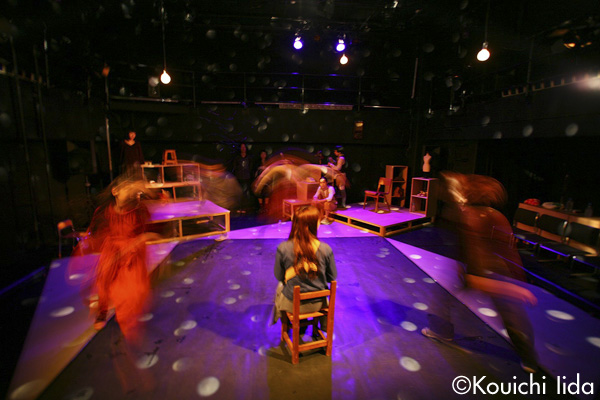
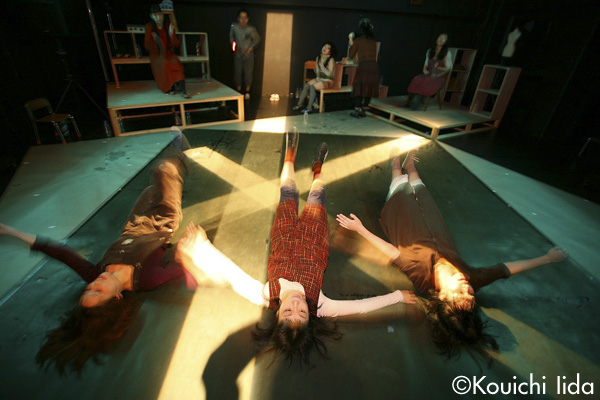
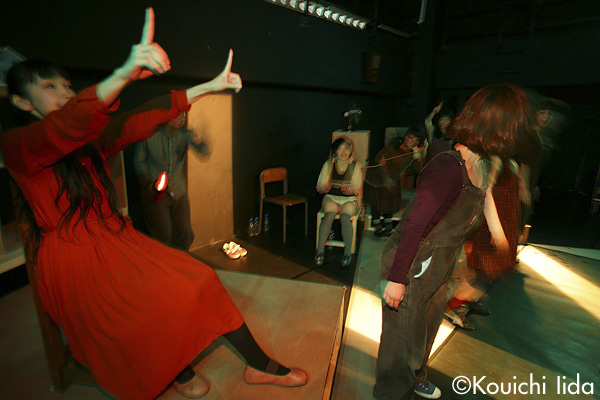
K to mayonaka no hotori de
(Nov 2011 at Komaba Agora Theatre) Photo: Kouichi Iida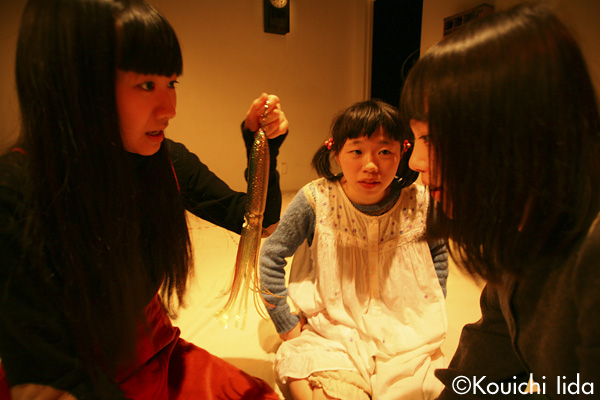
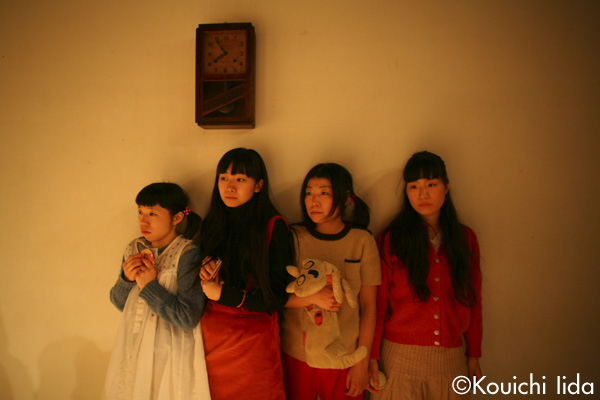
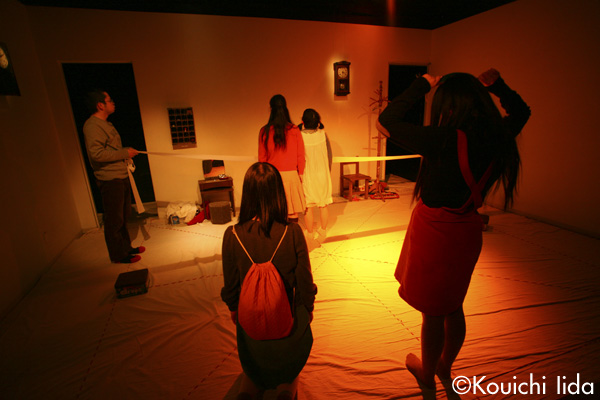
Kodomo mo Momo mo, Morin naka
(Premiere: Nov. 2010, Re-stage: Feb. 2011at Yokohama ST Spot)
Photo: Kouichi Iida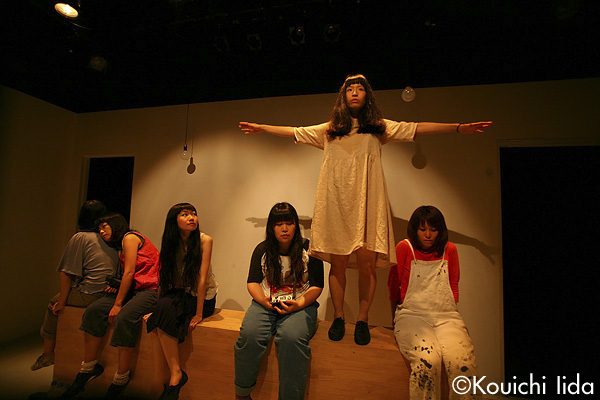
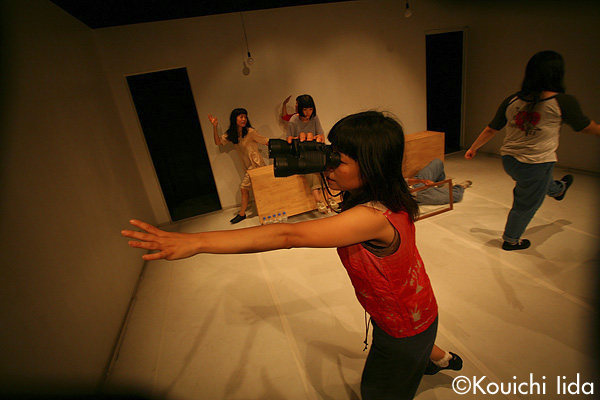
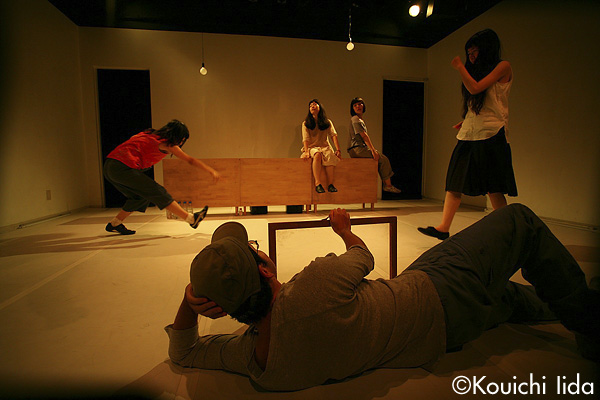
Shiofuru sekai
(Aug. 2011 at Yokohama ST Spot)
Photo: Kouichi Iida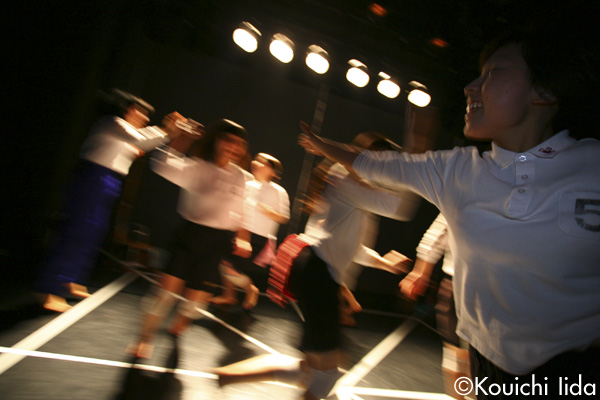
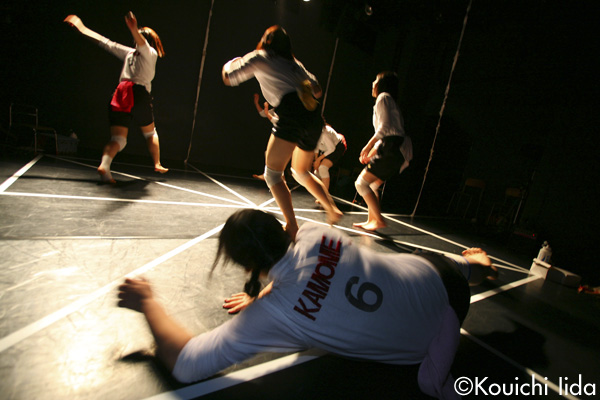
Hello school, bye bye
(Nov. 2010 at Atelier GEKKEN, Kyoto)
Photo: Kouichi IidaRelated Tags
Takahiro Fujita
Revealing the inner world of young women With scenes repeated as refrains
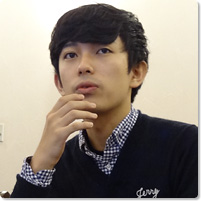
Takahiro Fujita
Born in April 1985 in the city of Date in Hokkaido. Fujita is playwright and director. He majored in Theater in the Comprehensive Culture Course of the Literature Department of Obirin University. In 2007, he formed the theater company Mum & Gypsy. New casts and staff are gathered for each production and its performances. The works are characterized by multiple “refrains” of the symbolic scenes. In 2011, at the age of 26, his trilogy Kaeri no Aizu,Matteta Shokutaku , soko kitto Shio Furu Sekai won the 56th Kishida Drama Award. Since then, he has actively created works in collaboration with artists from a variety of genres, while also working with participants of all ages regardless of their theater experience. Fujita created a theater production of the Machiko Kyo manga cocoon (2013, 2015) inspired by the young girls who were inducted into the final war effort in Okinawa at the end of WWII. In 2016, that work won Fujita the Best Director Award of the 23rd Yomiuri Theater Grand Prix. Besides his theater works, Fujita is also known for his essays and novels and collaborative manga works, and more.
Mum & Gypsy website:
http://mum-gypsy.com/
Interviewer: Akihiko Senda [theater clitic]

